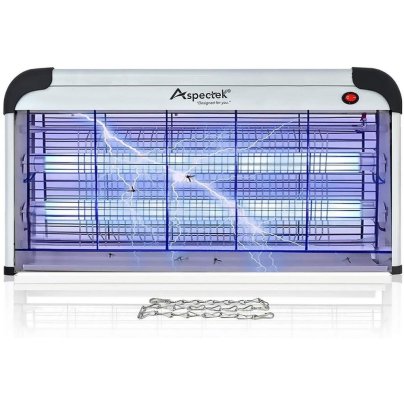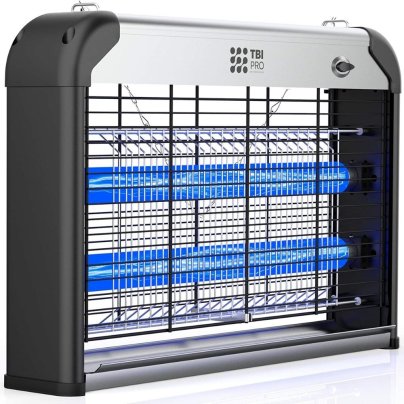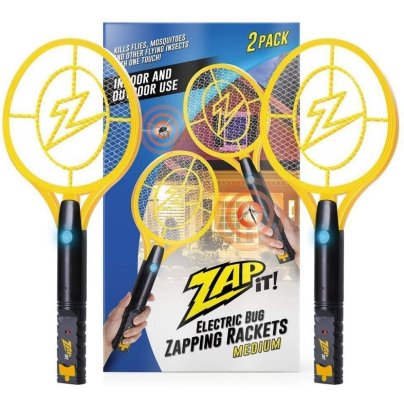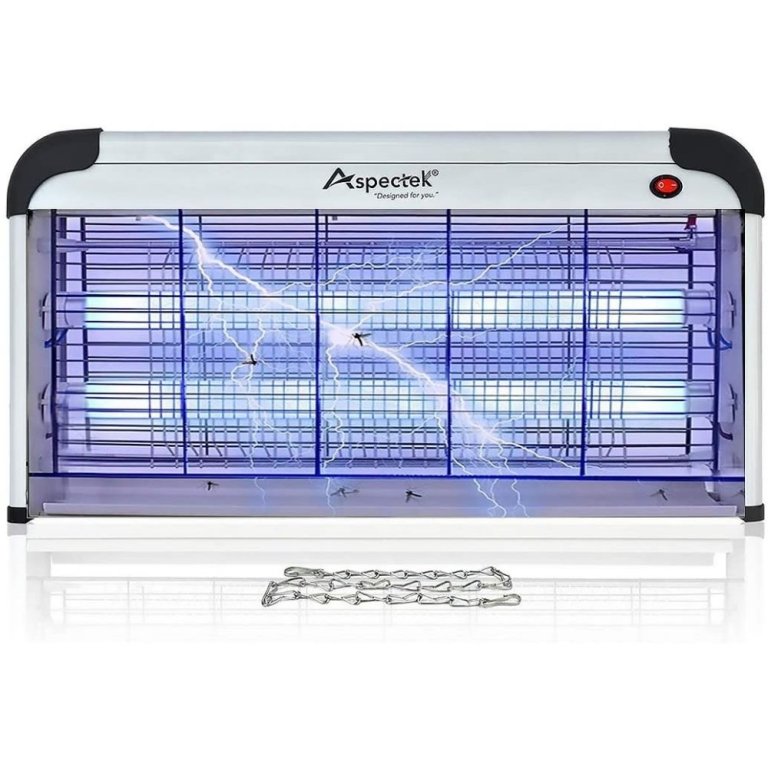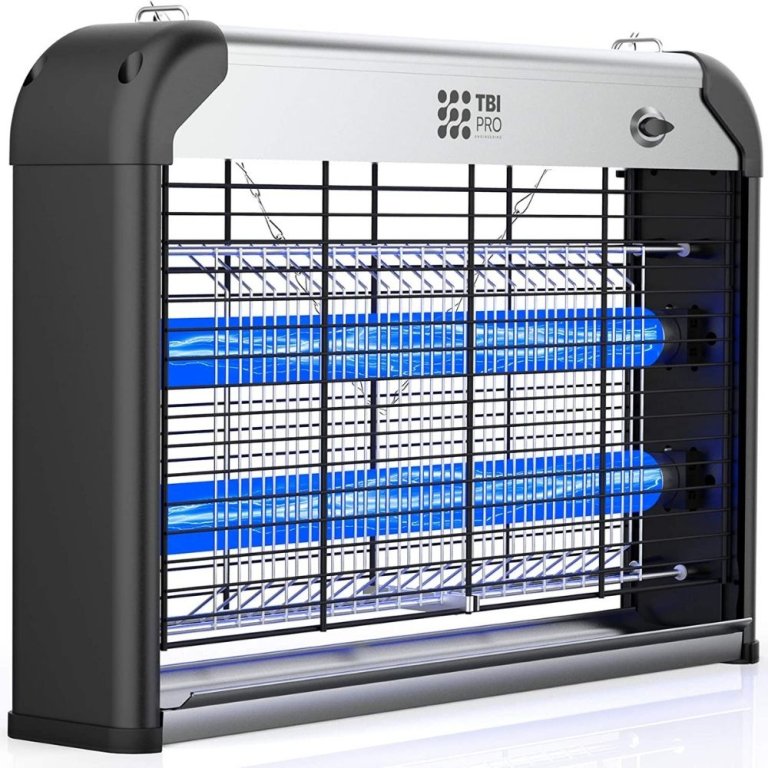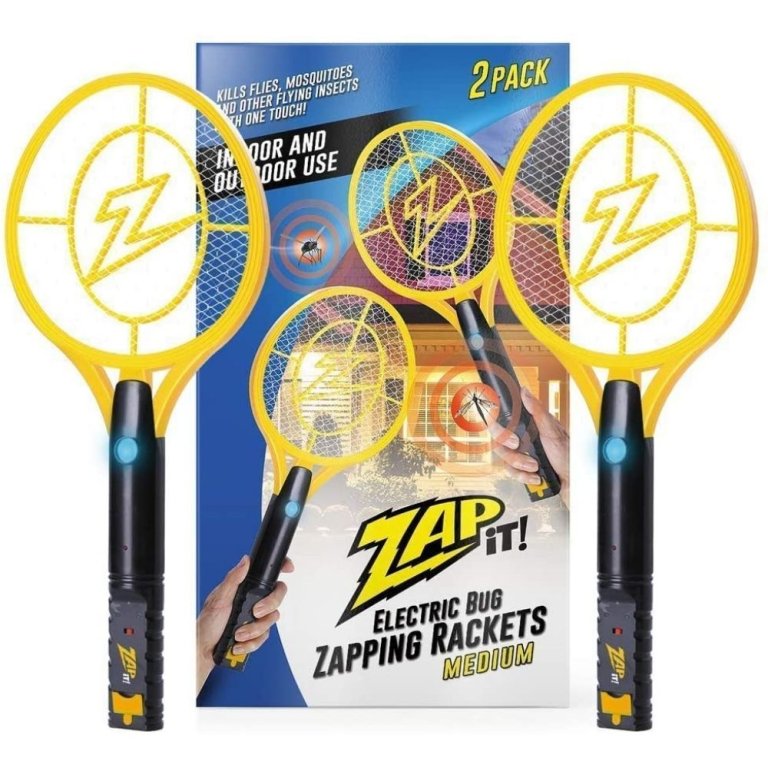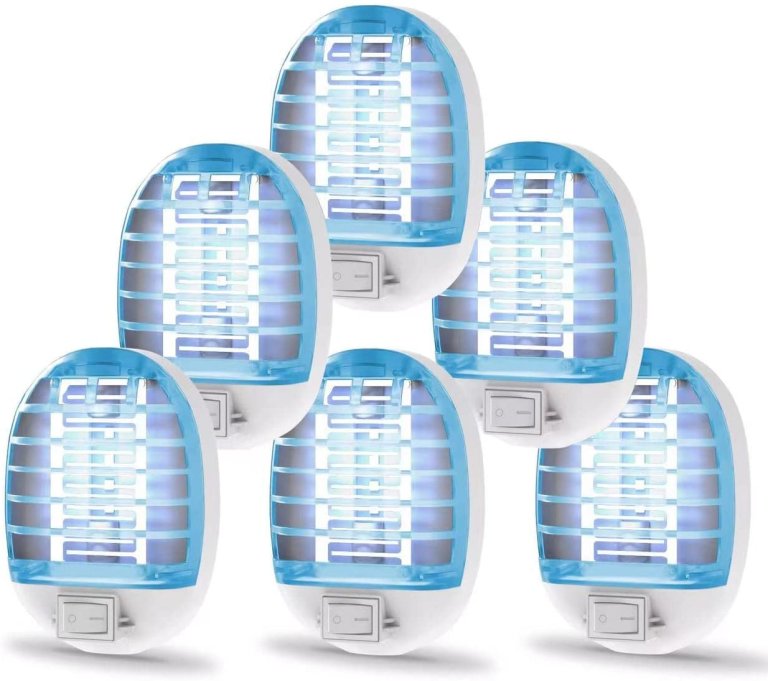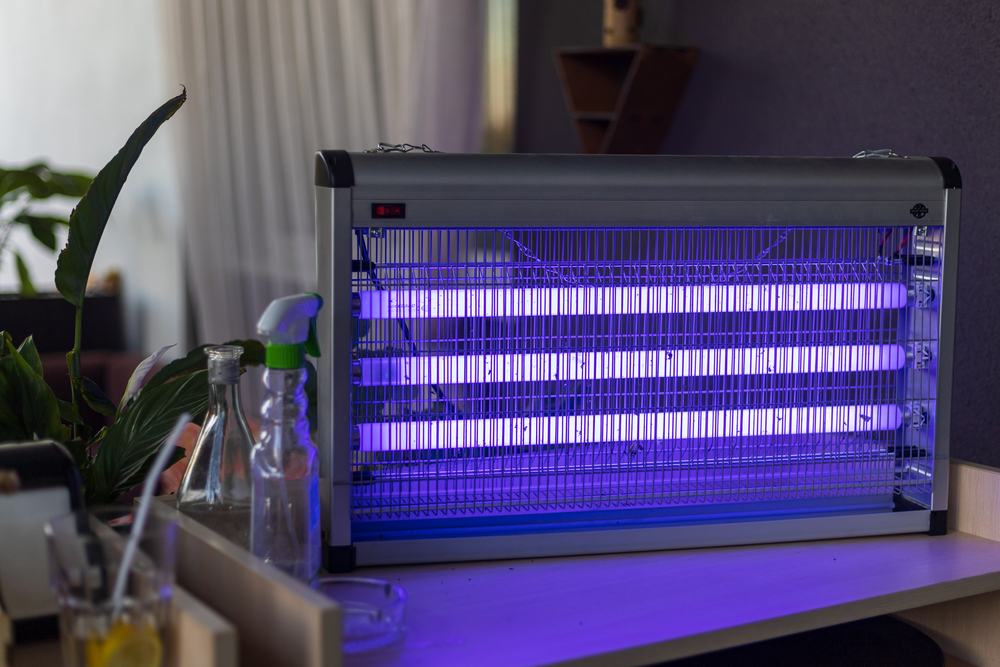
We may earn revenue from the products available on this page and participate in affiliate programs. Learn More ›
No one likes sharing their home with bugs, so when flies, moths, and other winged pests make their way inside, you want to find a way to send them packing. It can be time-consuming and frustrating to chase down and kill insects around the house, but with an indoor bug zapper, pests fly straight into their doom while you go about your day.
Indoor bug zappers generally don’t have to deal with the same number of bugs as outdoor bug zappers, so they are designed with a lower electrical output that is safe for indoor use but still gets the job done. Indoor models can also come with a bug collection tray for easy cleaning—no dead bugs all over the floor, countertop, or walls.
To find the best indoor bug zapper for your home, consider the top products below and continue reading for more information on what to look for when shopping for a bug zapper.
- BEST OVERALL: ASPECTEK Electronic Bug Zapper 40W
- RUNNER UP: Micnaron Electric Bug Zapper/Pest Repeller
- BEST HANDHELD: ZAP iT! Rechargeable Bug Zapper Racket
- ALSO CONSIDER: DEDADY Bug Zapper Indoor
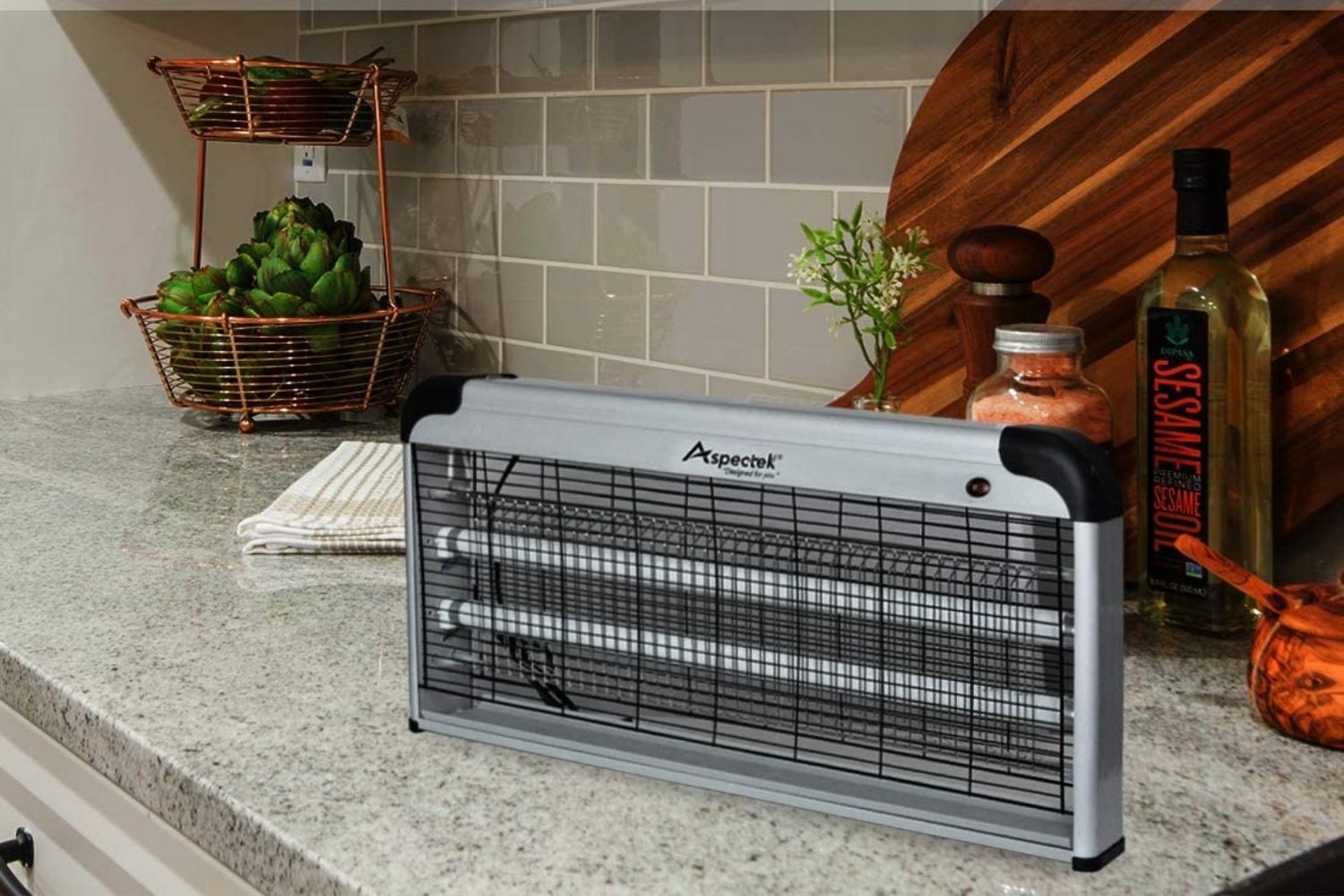
What to Consider When Buying the Best Indoor Bug Zapper
Finding an indoor bug zapper that will help rid the home of winged invaders doesn’t need to be difficult. To help in this search, look for the type of bug zapper that would be most suitable for your home based on size, coverage, attractants and a few other important considerations mentioned below.
Type
There are several types of indoor bug zappers, including wall fixtures, hanging, handheld, countertop, and light bulb models, and each has a range of functions and features that can make them more or less suitable for the situation.
- Wall fixture bug zappers are made to be plugged directly into an available electrical outlet without having to rely on batteries or on a power cord, which could pose a trip hazard.
- Hanging bug zappers are commonly used outdoors, but some products can also be hung up inside the home to attract and kill bugs. These bug zappers are a good option for homes with small children or pets because the device can be hung up high and out of reach.
- Handheld bug zappers often take the form of a flyswatter or a racket. This style of indoor bug zapper is a great choice for dealing with buzzing flies and mosquitoes that are hovering nearby. While they require some manual effort and hand-eye coordination, the satisfying crackling sound when the wires come in contact with a fly that has been swooping, landing, and hovering for hours is hard to replace with a stationary product.
- Countertop bug zappers are the most commonly used for indoor applications. They can be set up on just about any flat surface where the UV light (and any other applicable attractant) will draw insects to the electrically charged wires.
- Light bulb bug zappers screw into a standard light socket for power. The light produced by the bulb draws insects into the bulb, where they are killed by the high-voltage metal grid.
Size
The size of the bug zapper is an important consideration for drawing in insects, as larger UV lights attract a higher number of bugs to the electric wires. So it makes sense that as the bug zapper increases in size and light output, it also increases in coverage. Keep in mind, though, that even with a very large bug zapper, not all insects will be drawn toward it.
The number of bugs you want the device to attract is only one factor in choosing the bug zapper size. It’s also a good idea to determine where the indoor bug zapper will be set up. A very large bug zapper will take up a lot of space on a counter or bookshelf, while a hanging bug zapper can become a nuisance if it’s too big. The best indoor bug zapper will be large enough to draw in insects without being too large for its set up in the home.
Coverage
The coverage of an indoor bug zapper refers to the range at which the attractant can successfully lure insects to the electrified wires. Beyond this range, bugs may still notice and be drawn in, but the bug zapper won’t be as reliable. A typical range for an indoor bug zapper is relatively small compared to an outdoor product, but this is simply because there is no need (in most cases) for an indoor bug zapper to have coverage for very large spaces of up to an acre in size.
In fact, it’s much more common to find indoor bug zappers with a modest coverage range of just 1,000 square feet, especially when using a light bulb bug zapper or a wall fixture bug zapper. Countertop and hanging bug zappers normally exceed this range, with some that can be classified as both indoor and outdoor bug zappers. In general, the more powerful the wattage of the UV light or the scent of the chemical attractant, the wider the range of the bug zapper.
Attractants
The attractant in an indoor bug zapper is typically a UV light bulb that can have a bright white appearance or a deep purple appearance, depending on the bulb. These lights work well for luring flies, moths, fruit flies, and many other irritating pests, though they should operate at a frequency between 350 to 400 nanometers (nm) to attract mosquitoes. Light frequencies outside of this range are not effective at drawing in mosquitoes.
Mosquitoes are normally drawn to human breath and sweat, not light. To avoid repelling mosquitoes from the bug zapper, it’s a good idea to incorporate a chemical lure called octenol. This chemical is an irresistible attractant that’s found in the human mouth, breath, and sweat. With this mosquito bait in place and a strong UV light, the bug zapper should have no problem dealing with insects inside the home.
Power Source
Indoor bug zappers use electrified wires to kill flying and crawling insects, but to function properly they need a power source. Typically, a bug zapper will have a direct connection to a power outlet or it will be battery powered.
- Direct energy bug zappers are either attached directly to a power source, like a wall outlet or a light socket, or they are attached through a power cable. The benefit of a direct energy bug zapper is that it will never need to be recharged. This type of bug zapper can also have a stronger electrical output, allowing it to handle larger insects like hornets and wasps.
- Battery-powered bug zappers have the benefit of portability. They can be placed almost anywhere around the home, ensuring that insects are being drawn away from people. However, these devices do need the batteries to be replaced or recharged periodically, and if this isn’t done promptly, then they are little more than an odd decor choice.
Safety
Given that the main purpose of an indoor bug zapper is to lure and kill, it shouldn’t be a surprise that safety is a primary concern, especially in homes with small children and pets. Despite the size difference between people and insects, the electrified wires can still cause harm, producing a painful electric shock that burns the skin.
To help mitigate this safety risk, many indoor bug zappers will feature a plastic cage that encloses the electrified grid, preventing inquisitive fingers or snouts from touching it. A handheld bug zapper may look like a fun toy to a curious kid, so they are typically equipped with a lock button that holds the bug zapper in the off position, protecting little fingers from an accidental shock.
Aesthetic
It may seem strange that aesthetic appeal is a factor to consider when choosing an indoor bug zapper, but if this device is going to be sitting on the counter, hanging from the ceiling, or taking up power outlet space along the wall, it’s a good idea to find a product that blends into the decor. Many indoor bug zapper products are made with aesthetics in mind, offering a range of attractive designs.
Wall fixture and light bulb bug zappers are good choices that don’t draw a lot of attention, and a handheld bug zapper can easily be put away when guests are over. Hanging and countertop indoor bug zappers are more visible, so some models are designed to accentuate the existing decor instead of blending in. Choose a product that suits your personal preference and home aesthetic while still doing the job of ridding your home of irritating insects.
Our Top Picks
These top bug zapper products were selected based on their type, coverage, attractants, overall efficacy, and the other critical shopping factors mentioned above to help you find the best indoor bug zapper for eradicating invading insects.
Best Overall
ASPECTEK Electronic Bug Zapper 40W
Pros
- Fits on a countertop
- Includes a chain for wall hanging
- Kid and pet friendly
Cons
- Can be quite noisy
Product Specs
- Type: Hanging bug zapper
- Coverage: 6,000 square feet
- Power Source: Plug-in
Find a place on a countertop for this indoor bug zapper or hang it from a wall with the included chain to keep it out of the way. To use the bug zapper, simply plug it in and turn it on. The 360-degree protective grid keeps kids and pets away from the electrified wires while allowing pesky insects through.
This indoor bug zapper uses UV light to draw in flying insects like flies and moths, and it also has a secondary attractant that lures mosquitoes to the wires. With a large coverage range of 6,000 square feet and an output of 2,800 volts, this indoor bug zapper has no problem handling beetles, wasps, and other large pests. To clean the bug zapper, just pull out the tray, dispose of the dead bugs, and rinse with water.
Get the ASPECTEK indoor bug zapper at Amazon, Walmart, and The Home Depot.
Runner Up
Micnaron Electric Bug Zapper/Pest Repeller
Pros
- Long-range effectiveness
- Easy to clean
- Great for large areas
Cons
- Light can be distracting indoors
Product Specs
- Type: Hanging bug zapper
- Coverage: 6,000 square feet
- Power Source: Plug-in
The range of effect for any indoor bug zapper is determined by the strength of the UV light and the chemical attractant, if applicable. While this countertop bug zapper doesn’t use a chemical lure, it does have two large 40-watt UV lights that give this bug zapper an incredible range of one acre or 43,560 square feet. This impressive coverage ensures that invading bugs are drawn in from every corner of the house, with the exception of closed-off areas where the light cannot reach.
Use the 39-inch power cord to provide electrical power from an available outlet to the 2,800-volt electrified metal grid in order to kill flies, moths, gnats, wasps, hornets, and other flying or crawling bugs. This indoor bug zapper has a strong steel protective guard to help avoid accidental shocks, and a removable plastic tray in the bottom of the bug zapper collects the dead insects to make cleaning up much easier.
Get the Micnaron indoor bug zapper on Amazon.
Best Handheld
ZAP iT! Rechargeable Bug Zapper Racket
Pros
- Easy to use
- Affordable
- Rechargeable battery
- Built-in light
Cons
- Requires manual labor
Product Specs
- Type: Handheld bug zapper
- Coverage: Depends on the reach of the user
- Power Source: Rechargeable USB battery
Even the kids can get in on pest eradication with this inexpensive value pack that includes two bug zapper rackets that are equipped with a triple layer of mesh on both sides to prevent accidental zaps. Each racket also has a safety switch at the base of the handle and an LED light to allow the bug zappers to be used anytime throughout the day in light or dim conditions.
The bug zapper rackets are battery powered with up to 10,000 zaps in a single full charge. When the bug zapper begins to run low on power, just plug it in using the included USB cable to quickly recharge the battery and get back to killing pesky insects. The rackets can handle flies, mosquitoes, spiders, yellow jackets, hornets, beetles, and wasps with no problem due to the electrical output of 4,000 volts.
Get the ZAP IT! indoor bug zapper on
and at
.
Also Consider
DEDADY Bug Zapper Indoor
Pros
- Ideal for covering an entire home
- Compact unit
- Comes with six units
Cons
- Each unit has quite a low range
Product Specs
- Type: Wall plug-in bug zapper
- Coverage: 300 square feet each
- Power Source: Plug-in
This set of six bug zappers can be used to provide coverage throughout the entire home. Each of the zappers plugs into an open power outlet and draws energy once turned on using the simple on/off switch located on the front of each device.
When activated, the bug zapper puts out UV light to attract flies, mosquitoes, and ants to the electrified wires within. The wires are covered with a hard plastic guard so that bugs can get through, but little hands and curious pets are protected from the electricity.
Individually, these zappers have a modest range, but because there are six in the set, and because the zappers are designed to be conspicuous, they can be used in multiple throughout the home, if necessary.
Get the DEDADY indoor bug zapper on Amazon.
Our Verdict
For a reliable unit that can get the job done effectively, consider the ASPECTEK Electronic Bug Zapper, which is easy to clean and covers a large area.
How We Chose the Best Indoor Bug Zappers
The best bug zappers are reliable and able to take care of an insect problem in a simple and effective way. Our list of recommendations includes a range of products for shoppers to choose from depending on their personal preferences—with a selection of hanging, handheld, countertop, and light bulb bug zappers on our list.
Our top picks boast impressive coverage, with some able to keep several thousand square feet protected from annoying critters. We also made sure to include more compact units that can fit discreetly into rooms in the house without causing too much distraction but still able to get the job done.
FAQs
Before investing in a new indoor bug zapper, take a look at these frequently asked questions and their answers to learn more about what bug zapper is most appropriate for keeping your home pest-free.
Q. Where do I place an indoor bug zapper?
The most effective placement indoors is in an open area that is out of sight of exterior windows and doors. This is because the bug zapper will be able to attract any insects that are inside the home without drawing in additional bugs from outside.
Q. Can a bug zapper hurt humans?
Yes. Do not touch the wires. While a bug zapper won’t kill a person, it will burn whatever part of the body completes the electrical circuit between two or more wires.
Q. Do bug zappers attract mosquitoes?
Most bug zappers aren’t a good choice for treating mosquito problems because mosquitoes are only attracted to a very narrow frequency of UV light between 350 to 400 nm. However, if the bug zapper can be used with an octenol packet, it will be much more successful in attracting and killing mosquitoes.
Q. Do bug zappers make noise?
Bug zappers usually produce a low, vibrating tone when they are turned on and may make a buzzing and crackling noise when an insect comes in contact with the electrically charged wires.
Q. Can I leave a bug zapper on all night?
A bug zapper can be left on all night, but leaving any exposed electric device running without supervision is a safety risk. If you choose to leave the bug zapper on, just make sure that it’s set up away from flammable objects.
Q. How long do bug zappers last?
On average, bug zappers work for about 5,000 hours before the UV lamp needs to be replaced. This means that if a brand-new bug zapper is turned on and left on, it should continue working nonstop for about seven months. For optimal results and long life, turn on the bug zapper for about four hours at a time.
